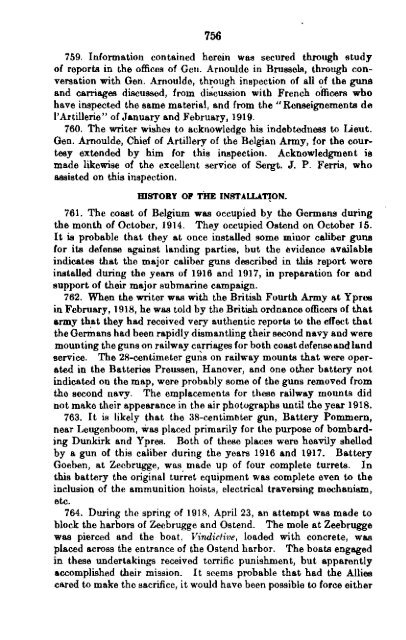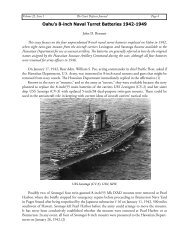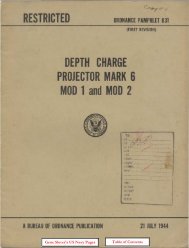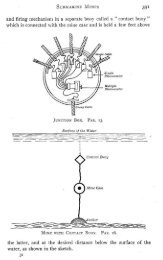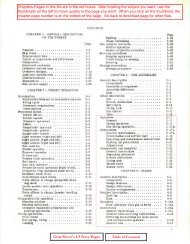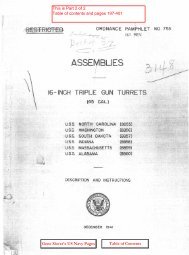...Railway artillery - Personal Page of GENE SLOVER
...Railway artillery - Personal Page of GENE SLOVER
...Railway artillery - Personal Page of GENE SLOVER
You also want an ePaper? Increase the reach of your titles
YUMPU automatically turns print PDFs into web optimized ePapers that Google loves.
756<br />
759. Information contained herein was secured through study<br />
<strong>of</strong> reports in the <strong>of</strong>fices <strong>of</strong> Gen. Arnoulde in Brussels, through conversation<br />
with Gen. Arnoulde, through inspection <strong>of</strong> all <strong>of</strong> the guns<br />
and carriages discussed, from discussion with French <strong>of</strong>ficers who<br />
have inspected the same material, and from the It Renseignements de<br />
l'Artillerie" <strong>of</strong> January and February, 1919.<br />
760. The writer wishes to acknowledge his indebtedness to Lieut.<br />
Gen. Arnoulde, Chief <strong>of</strong> Artillery <strong>of</strong> the Belgian Army, for the coUrtesy<br />
extended by him for this inspection. Acknowledgment is<br />
made likewise <strong>of</strong> the excellent service <strong>of</strong> Sergt. J. P. Ferris, who<br />
assisted on this inspection. .<br />
HlSTORY·OJl' TilE INSTALLAT!ON.<br />
761. The coast <strong>of</strong> Belgium was occupied by the Germans during<br />
the month <strong>of</strong> October, 1914. They occupied Ostend on October 15.<br />
It is probable that they at once installed some minor caliber guns<br />
for its defense against landing parties, but the evidence available<br />
indicates that the major caliber guns described in this report were<br />
installed during the years <strong>of</strong> 1916 and 1917, in preparation for and<br />
support <strong>of</strong> their major submarine campaign.<br />
762. When the writer was with the British Fourth Army at Ypres<br />
in February, 1918, he was told by the British ordnance <strong>of</strong>ficers <strong>of</strong> that<br />
army that they had received very authentic reports to the effect that<br />
the Germans had been rapidly dismantling their second navy and were<br />
mounting the guns on railway carriages for both coast defense and land<br />
service. The 28-centimeter guns on railway mounts that were operated<br />
in the Batteries Preussen, Hanover, and one other battery not<br />
indicated on the map, were probably some <strong>of</strong> the guns removed from<br />
the second navy. The emplacements for these railway mounts did<br />
not make their appearance in the air photographs until the year 1918.<br />
763. It is likely that the 38-centim.,ter gun, Battery Pommem,<br />
near Leugenboom, was placed primarily for the purpose <strong>of</strong> bombarding<br />
Dunkirk and Ypres. Both <strong>of</strong> these places were heavily shelled<br />
by a gun <strong>of</strong> this caliber during the years 1916 and 1917. Battery<br />
Goeben, at Zeebrugge, was made up <strong>of</strong> four complete turrets. In<br />
this battery the original turret equipment was complete even to the<br />
inclusion <strong>of</strong> the ammunition hoists, electrical traversing mechanism,<br />
etc.<br />
764. During the spring <strong>of</strong> 1918, April 23, an attempt was made to<br />
block the harbors <strong>of</strong> Zeebrugge and Ostend. The mole at Zeebrugge<br />
was pierced and the boat, Vindictive, loaded with concrete, was<br />
placed across the entrance <strong>of</strong> the Ostend harbor. The boats engaged<br />
in these undertakings received terrific punishment, but apparently<br />
accomplished their mission. It seems probable that had the Allies<br />
eared to make the sacrifice, it would have been possible to force either<br />
Digitized by Coogle


